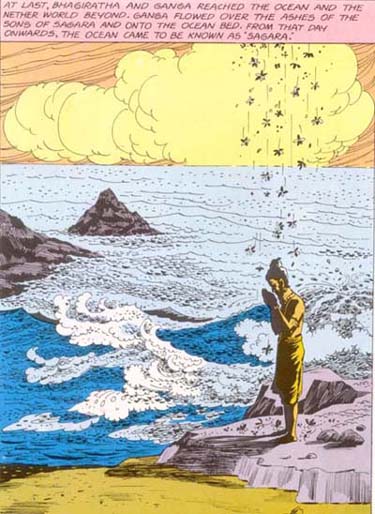
Ganga Mythology

As the root of ancient civilization in northern India Ganga has been integrated from time immemorial into the canon of Hindu literature, finding her place in the great epics, the Ramayana and the Mahabharata as well as Puranic texts, including the Ganga Mahatmyas. Her hagiography varies throughout the texts but her most popular myth is the celebration of her descent to earth to purify the souls of men. In the popular version the great king Sagaraís sixty thousand sons are burnt to ashes as punishment for disturbing the meditation of the sage Kapila. The impudence of such an act could not go unnoticed but the remaining generations managed to call down Ganga to redeem their souls. Bhagiratha, son of Sagara, was able to, through the heat of his austerities, propitiate Ganga and she fell to earth to purify and wash away the wrongdoing of Sagaraís sons. Before arriving in this world, however, Siva had to act as a landing pad, for the strength of her fall would have been to great for this world to endure. Catching her in his matted locks Lord Siva mediates and tames the flow of Ganga from the heavens into this world. Thus the river represents a gateway to purity and absolution for Sagaraís sons. In its flow can be found a means to heavenly ascent. In this way Ganga is considered "a soaring ladder to heaven for the sons of Sagara: svarga sopana panktim." (Sivaramamurti 1976: 1)
Ganga mythology is popularized in contemporary Amar Chitra Katha comic books
Ganga is the holy water found to be in the kamandalu, or water vessel, of Brahma. The practice of abhiseka, purifying the inner and outer self with tirtha-jal, or pilgrimage water, usually begins and ends Vedic sacrifices and ceremonies and is the domain of Brahma who initiates Vedic ritual. "Poured on the head as in abhiseka, she purifies the outer frame, the physical body. By a sip or acamana, she purifies the interior of the bodyÖFrom the water vessel she is poured on the feet of a worshipful one as a token of respect and welcome." (Sivaramamurti 1976: 1)
The pouring of the sacred water on the foot is of great importance to Hindu tradition. It is said that as Vishnu raised his foot towards the heavens in his Trivikrama form blackening the entire universe as he took three strides to cover the three worlds Brahma hastened to supplicate Vishnu by pouring water from his kamandalu. This, too, is the origin of Ganga, flowing downward, skating off Vishnuís foot as Vishnupadi. Another version posits that with his third step Vishnuís toe pierced the heavenly vault, releasing its waters (Eck 1982: 175). In both myths Ganga descends from heaven and the sky and meets the earth joining the two through the body of Vishnu (Sivaramamurti 1976: 3).
| Ganga Ma | Ganga Mythology | Ganga Today | Cleanup efforts and the Dilemma | Bibliography |